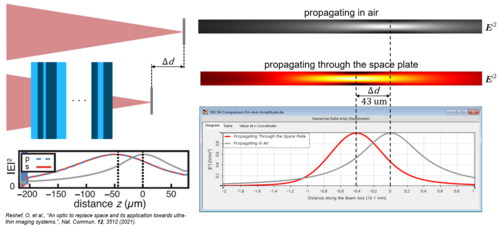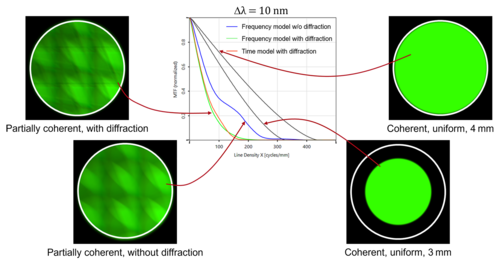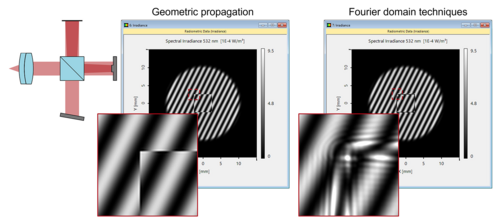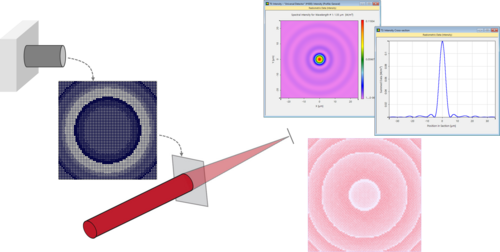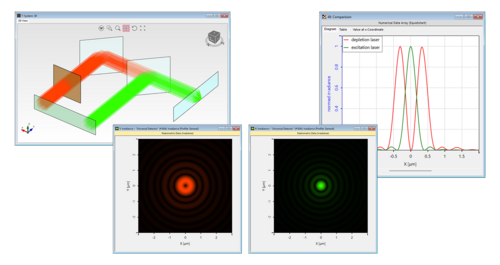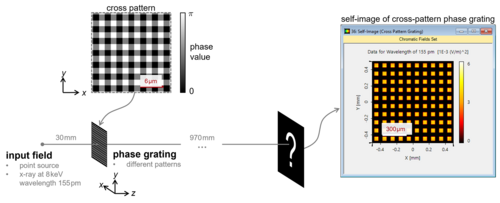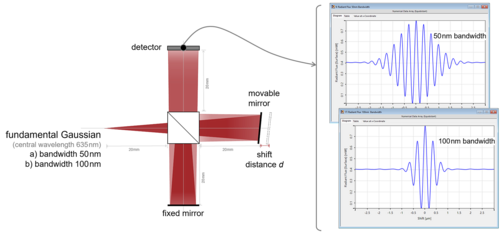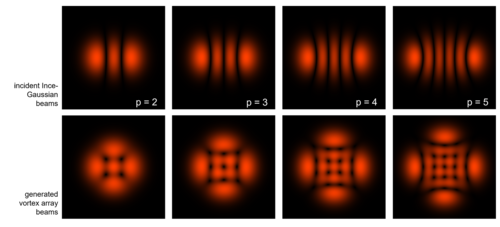What’s new in our Optical Modeling and Design Software?
Simulation of Multilayered Metasurface Space Plate
There is a widespread tendency in many modern optical design applications to make the system as compact as possible. Cameras in mobile phones are one of the most mainstream examples of this tendency. Although the focus is usually on the imaging components themselves (trying to reduce the bulk in lenses by moving towards flat components, for instance), addressing the distances between components is also necessary in order to make the system as small as possible while retaining the desired function. This can be achieved, for example, by folding the system on itself to utilize the same volume for multiple propagation steps, but that is not the only available strategy.
In this week’s newsletter we present the simulation of a multilayered metasurface space plate (as proposed by O. Reshef et al. in their publication “An optic to replace space and its application towards ultra-thin imaging systems.”, Nat. Commun. 12, 3512 [2021]): a flat component capable of replicating the response of a free-space propagation step much longer than the actual physical thickness of the component.
The optical modeling and design software VirtualLab Fusion offers a rich pool of interoperable modeling techniques on a single software platform, which allows us to select the rigorous S-matrix algorithm for the multilayered structure of the space plate and combine it with other methods, like those for free-space propagation or any additional components present, to complete the simulation of the whole system with the perfect balance between accuracy and speed.
Do take a look at the documents below to find out more about the space plate example, as well as a deep-dive document into our Stratified-Media component, which can be used to construct such layered components.
MTF Analysis of Augmented-Reality Waveguide Devices
Grating-based waveguides have come to dominate the field of Augmented & Mixed Reality (AR & MR). The ultimate test of these devices is to obtain a good reconstruction of the digitally generated image at the retina of the user of the device. This aspect of the performance is typically characterized through the modulation transfer function (MTF), which quantifies the resolution capabilities of an imaging system. Unlike eye-box uniformity (another vital measure of the quality of an augmented reality gadget, since low uniformity can cause extremely uncomfortably strobing and flickering effects), the MTF is extremely sensitive to the temporal coherence properties of the source as well as any diffraction which may evolve, not just in the last propagation step to the retina (a given, since we are propagating into a focus), but also, crucially, also diffraction that evolves upon propagation inside the waveguide (typically caused by truncations at the boundaries of grating regions).
The optical modeling and design software VirtualLab Fusion provides the perfect tools to face these challenging design tasks. The flexibility provided by its pool of modeling techniques, implemented on a single software platform for maximum seamlessness in their interoperability, allows the optical designer to strike the necessary balance between accuracy and speed each time – with simulations that are as accurate as needed, and as fast as possible. If you still need convincing, go ahead and take a look at the examples below!
Diffraction Effects in Interferometry
Optical interferometry – experimental measurement techniques based on the extraction of information from the interaction of light with itself, mostly through the intensity modulation that results from relative phase differences between coherent overlapping fields – is used in many different fields of application, ranging from microscopy to astronomy. While many of those applications can be modeled accurately enough while ignoring diffractive effects, in certain cases, such as when sharp edges or narrow apertures are present in the system, a model capable of taking into account the evolution of diffraction needs to be selected.
VirtualLab Fusion’s flexible pool of interoperable modeling techniques on a single platform helps you achieve the appropriate accuracy-speed balance for your simulation: diffraction effects can be taken into account only when necessary. As a demonstration example, please find below an analysis of a rectangular object sample in an interferometric system. This example includes a comparison of how the result looks depending on whether diffraction is considered or not. Staying with interferometry, we also showcase a demonstration of the working principle of Optical Coherence Tomography (OCT), one of the most important forms of medical imaging.
Read moreOptical Metastructures
Through recent advances in technology, the manufacture of components that use subwavelength structures capable of replicating certain desired emerging properties has become possible for a growing number of applications.
Simulation technology for these so-called metamaterials comes with its own set of challenges, mainly due to the nanoscale structure and high refractive index contrast. The extremely flexible interoperability of modeling techniques offered on a single platform by the optical modeling and design software VirtualLab Fusion allows us, also in this scenario, to adjust the speed-accuracy balance of the simulation to obtain results which are as accurate as needed, as fast as possible.
Take a look at the use cases linked below to find an example showcasing the design of a metalens based on a subwavelength pillar structure.
There is also a deep-dive document explaining the details of our pillar medium, used to model the metalens component in said example.
Stimulated Emission Depletion (STED) Microscopy
Super-resolution microscopes – optical systems that can achieve resolution beyond Abbe’s well-known diffraction limit – have seen a wide array of uses, as obtaining the maximum possible resolution is one of the key objectives in this field. One approach to achieve this is the Stimulated Emission Depletion (STED) concept. Here, a fluorescent specimen is illuminated by two lasers, with one of them shaped by a phase plate into a donut mode. Through chemical processes, the light re-emitted by the sample will stem from the central point of the donut mode only, which can be configured to be much smaller than a classical focal spot, hence increasing the resolution of the image.
The optical modeling and design software VirtualLab Fusion, with its collection of fully interoperable simulation algorithms on a single platform, offers the optical engineer all the necessary tools to fully investigate such systems, including all relevant effects.
In the documents linked below you will find a demonstration of an STED Microscope as well as a detailed look at our Multiple Light Source, a feature of particular importance for this example, since it gives full flexibility to define multiple emitters in a system and to switch each of them on and off independently as desired in order to isolate the different effects which may arise.
Talbot Effect in X-Ray Imaging
X-ray imaging has seen many applications in e.g. the areas of medical imaging and industrial inspection. A common design of X-ray imaging devices is based on the Talbot effect – a diffractive effect, where a periodic structure, like a grating, will produce the exact image of the structure at a certain distance behind it.
Being a software platform based on fast physical optics, VirtualLab Fusion offers suitable solvers to propagate light through such devices, including all diffractive effects. For a short demonstration of VirtualLab Fusion’s capabilities in this area, check out the examples below:
Fourier Transform Spectroscopy
Fourier Transform spectroscopy – an optical metrology method that can be used to measure the optical spectrum of a source with a Michelson interferometer – is a
well-known technique commonly used in a wide range of applications that can go from investigating air or water quality to pharmaceutical analysis.
To help the optical designer understand all the effects that can play a role in such devices, the fast physical optics software VirtualLab Fusion provides all the necessary tools to perform a full propagation through these systems. This naturally includes all coherence and interference effects that are happening at the detector plane. Furthermore, through our new Detector Add-Ons, the user has access to all physical quantities that are of interest, such as irradiance or radiant flux.
Please take a look at the links below to find an example where the temporal coherence length of a polychromatic source is investigated through a Michelson interferometer, as well as some thorough documentation of our Detector Add-Ons.
Ince-Gaussian Beams for Optical Tweezer
Optical tweezers, scientific instruments that utilize highly focused beams to manipulate objects on a sub-microscopic level, can be used to hold individual cells or molecules and have therefore been used for many applications in biology, medicine and nano-chemistry.
To ensure proper functionality of these setups, the beam employed needs to have a stable structure throughout the focusing process. While multiple different fundamental Gaussian, Hermite- or Laguerre-Gaussian modes are good candidates for the task, a setup first proposed by Chu et al. [Opt. Express 16, 19934-19949 (2008)] uses Ince-Gaussian beams, as they are able to create stable 2D-light patterns of increasing complexity.
In the fast physical optics modeling and design software VirtualLab Fusion, the Ince-Gaussian source allows the user to easily configure a custom Ince-Gaussian Mode and use it as a source for their system. Combining this source with a non-sequential modeling approach we demonstrate a full simulation of the system proposed by Chu et al. Please also find below a detailed document describing the functionality and usage of the Ince-Gaussian beam source.




